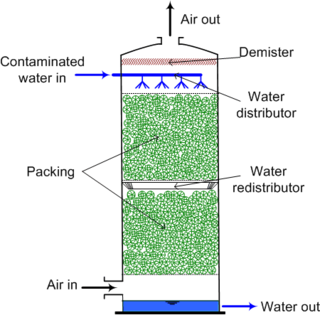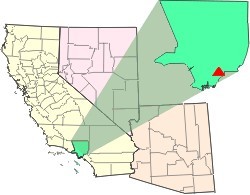Related Research Articles

Tetrachloroethylene, also known under the systematic name tetrachloroethene, or perchloroethylene, and abbreviations such as "perc" (or "PERC"), and "PCE", is a chlorocarbon with the formula Cl2C=CCl2. It is a colorless liquid widely used for dry cleaning of fabrics, hence it is sometimes called "dry-cleaning fluid". It also has its uses as an effective automotive brake cleaner. It has a mild sweet odor, similar to the smell of chloroform, detectable by most people at a concentration of 1 part per million (1 ppm).

Trichloroethylene (TCE) is a halocarbon with the formula C2HCl3, commonly used as an industrial degreasing solvent. It is a clear, colourless, non-flammable, volatile liquid with a chloroform-like pleasant mild smell and sweet taste. Its IUPAC name is trichloroethene. Trichloroethylene has been sold under a variety of trade names. Industrial abbreviations include TCE, trichlor, Trike, Tricky and tri. Under the trade names Trimar and Trilene, it was used as a volatile anesthetic and as an inhaled obstetrical analgesic in millions of patients. It should not be confused with the similar 1,1,1-trichloroethane, which is commonly known as chlorothene.

Environmental remediation is the cleanup of hazardous substances dealing with the removal, treatment and containment of pollution or contaminants from environmental media such as soil, groundwater, sediment. Remediation may be required by regulations before development of land revitalization projects. Developers who agree to voluntary cleanup may be offered incentives under state or municipal programs like New York State's Brownfield Cleanup Program. If remediation is done by removal the waste materials are simply transported off-site for disposal at another location. The waste material can also be contained by physical barriers like slurry walls. The use of slurry walls is well-established in the construction industry. The application of (low) pressure grouting, used to mitigate soil liquefaction risks in San Francisco and other earthquake zones, has achieved mixed results in field tests to create barriers, and site-specific results depend upon many variable conditions that can greatly impact outcomes.
Volatile organic compounds (VOCs) are organic compounds that have a high vapor pressure at room temperature. High vapor pressure correlates with a low boiling point, which relates to the number of the sample's molecules in the surrounding air, a trait known as volatility.

Air stripping is the transferring of volatile components of a liquid into an air stream. It is an environmental engineering technology used for the purification of groundwaters and wastewaters containing volatile compounds.

The Indian Bend Wash area is a Superfund cleanup site in Scottsdale and Tempe, Arizona. It was declared a Superfund site in 1983 after industrial solvents were discovered to have contaminated the groundwater in an approximately 13-square-mile (34 km2) area. It is one of the largest EPA sites in terms of volume of groundwater treated, estimated at 61.3 billion US gallons (232,000,000 m3).

The Brio Superfund site is a former industrial location in Harris County, Texas at the intersection of Beamer Road and Dixie Farm Road, about 16 miles (26 km) southeast of downtown Houston, and adjacent to the Dixie Oil Processors Superfund site. It is a federal Superfund site, although it was deleted from the National Priorities List in December 2006. A neighboring residential subdivision called South Bend, now abandoned, was located along and north of the northern boundary of Brio North. The former South Bend neighborhood consisted of about 670 homes, an elementary school, and a Little League baseball field. Documents pertaining to the Brio Superfund site are located at the San Jacinto College South Campus Library, which houses Brio Site Repository Documents, U.S. Environmental Protection Agency (EPA) Administrative Records, and documents concerning the adjoining Dixie Oil Processors site.
Groundwater remediation is the process that is used to treat polluted groundwater by removing the pollutants or converting them into harmless products. Groundwater is water present below the ground surface that saturates the pore space in the subsurface. Globally, between 25 per cent and 40 per cent of the world's drinking water is drawn from boreholes and dug wells. Groundwater is also used by farmers to irrigate crops and by industries to produce everyday goods. Most groundwater is clean, but groundwater can become polluted, or contaminated as a result of human activities or as a result of natural conditions.
Pemaco is a former chemical mixing company and facility located on the Los Angeles River in Maywood, a small city in southeastern Los Angeles County, California.
The FMC Corporation (Fridley Plant) is a United States Environmental Protection Agency Superfund site of 18 acres (7.3 ha) in Anoka County, Minnesota, United States, several hundred feet east of the Mississippi River. Solvents, paint sludge, and plating wastes were generated and disposed of in an on-site dump from the 1940s until 1969. Minnesota Pollution Control Agency (MPCA) staff sampled site surface and groundwater in the early 1980s and confirmed that ground and surface water were contaminated by industrial solvents. In the 1980s, solvents from the site were detected in the city of Minneapolis drinking water system intake that is located downgradient of where the FMC site groundwater contaminant plume enters the river.
The Freeway Sanitary Landfill is a United States Environmental Protection Agency Superfund site that covers 140 acres (57 ha) in Burnsville, Minnesota. In 1971 the Minnesota Pollution Control Agency (MCPA) licensed the landfill to accept 1,920 acre-feet (2,370,000 m3) of household, commercial, demolition, and nonhazardous industrial wastes. The state permit prohibited the disposal of liquids and hazardous wastes; however, heavy metals, acids, and bases were accepted by the landfill from local industries. The landfill also accepted 200 cubic yards (150 m3) of battery casings and 448 short tons (406,000 kg) of aluminum sweat furnace slag. Overall, the landfill contains nearly 5,000,000 cubic yards (3,800,000 m3) of waste. The waste is covered by a low permeability soil cover.

The Waste Disposal Inc. Superfund site is an oil-related contaminated site in the highly industrialized city of Santa Fe Springs in Los Angeles County, California. It is approximately 38 acres (15 ha), with St Paul's high school immediately adjacent to the northeast corner of the site. Approximately 15,000 residents of Santa Fe Springs obtain drinking water from wells within three miles (4.8 km) of the site.

Groundwater pollution occurs when pollutants are released to the ground and make their way into groundwater. This type of water pollution can also occur naturally due to the presence of a minor and unwanted constituent, contaminant, or impurity in the groundwater, in which case it is more likely referred to as contamination rather than pollution. Groundwater pollution can occur from on-site sanitation systems, landfill leachate, effluent from wastewater treatment plants, leaking sewers, petrol filling stations, hydraulic fracturing (fracking) or from over application of fertilizers in agriculture. Pollution can also occur from naturally occurring contaminants, such as arsenic or fluoride. Using polluted groundwater causes hazards to public health through poisoning or the spread of disease.
The Newmark Groundwater Contamination Site is a Superfund site located at the base of the San Bernardino Mountains in Southern California. The contamination was discovered in 1980 and resulted in the closing of 20 water supply wells and intensive cleanup efforts in the following years. More than 25 percent of the San Bernardino municipal water supply has been affected by the water contamination since its discovery. The source of the contamination is attributed to a World War II Army landfill and depot, used from 1942 to 1947.
Kauffman & Minteer Inc. (K&M) was an industrial transportation company that operated from 1960 to 1981 in Burlington County, New Jersey. After cleaning their trucks, they dumped the waste water into a nearby lagoon that was not properly lined. The lagoon flooded and the waste water containing chemicals, migrated over to wetlands, causing damage to vegetation and seeping into underground drinking water. The Environmental Protection Agency (EPA) got involved in 1989 and conducted a few remediation attempts but the extent of the damage is hard to determine as the different underground pathways of water are unpredictable. The site is currently an active superfund site that is closely monitored by the EPA.
Emmell's Septic Landfill (ESL) is located at 128 Zurich Ave, Galloway Township, New Jersey and takes up about 38 acres of space. The landfill was in operation from 1967 until 1979. ESL disposed of liquid and solid waste including many chemicals such as volatile organic compounds (VOCs), Polychlorinated Biphenyls (PCBs), Trichloroethene and Vinyl chloride which all had their own effect on the environment and community. These chemicals affected the groundwater required millions of dollars to reconstruct the groundwater pathways and provide clean water to residents. The landfill holds a Hazardous Ranking Score of a 50/100, qualifying for the Superfund National Priority List. In August 1999, the state acknowledged the site's contamination and held town meetings and provided research upon the site such as groundwater samples. In July 1997, a sitewide investigation was called upon by the United States Environmental Protection Agency. In total the clean up was estimated to cost $5 million to fund this superfund site, and a grant of $3.9 million was given by the Federal Government under the Recovery Act Funding (Previti). Today, the project is still ongoing however, greatly improved since the landfill was discovered.
Bog Creek Farm, located in Howell Township, New Jersey, is a designated Environmental Protection Agency (EPA) Superfund site. Lying on 12 acres of land, Bog Creek Farm is home to several hazardous and life-threatening contamination beginning in 1973 and continuing for a year. Over a decade later, actions began to take place to clean and restore the contaminated soil and water. Bog Creek Farm is situated near several other farms that house horses, growing crops and flowers, and livestock. Less than a mile down the road lies Allaire State Park, a park used by golfers, hunters, and fisherman.
Brook Industrial Park (BIP) is an industrial area occupying 4.5 acres of the Borough of Bound Brook, New Jersey, in the United States of America. It is located on the northern bank of the Raritan River. Industrial, chemical and pesticide operations began in 1971 and eventually lead to the contamination of groundwater and exposure of workers to harmful dioxins. Throughout 1980 to 1988 the United States Environmental Protection Agency (EPA) and the New Jersey Department of Environmental Protection (NJDEP) conducted studies to determine if there were any threats being posed on the workers, community or environment by the BIP companies in their disposal of processed and stored chemicals.
Sharkey Landfill is a 90-acre property located in New Jersey along the Rockaway and Whippany rivers in Parsippany, New Jersey. Landfill operations began in 1945, and continued until September 1972, when large amounts of toluene, benzene, chloroform, dichloroethylene, and methylene chloride were found, all of which have are a hazard to human health causing cancer and organ failure. Sharkey Landfill was put on the National Priority List in 1983, and clean up operations ran until the site was deemed as not a threat in 2004.
References
- ↑ CDC. (2004). Fetal Alcohol Syndrome: Guidelines for Referral and Diagnosis. Can be downloaded at https://www.cdc.gov/fas/faspub.htm "Unknown" . Retrieved December 29, 2023.[ dead link ]
- ↑ EPA report on the A. L. TAYLOR SITE - page 5